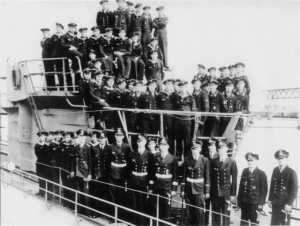- Author
- Wright, Ken
- Subjects
- Naval Intelligence, Ship histories and stories, History - WW2, WWI operations
- Tags
-
- RAN Ships
- None noted.
- Publication
- March 2007 edition of the Naval Historical Review (all rights reserved)
By May 1943, Germany had lost the U-boat war in the Atlantic. U-boat losses had reached an intolerable level with the loss of 38 U-boats for May alone. The Allies had an advantage called Bletchley Park. Known as ‘Station X’, their task was to break the ingenious Enigma machine cipher used for German high-level communications. The settings for the Enigma machine changed continually and each day the German operators had 159 million million million different possibilities. Yet against all odds they achieved the impossible, coping with even greater difficulties to break ‘SHARK’, the U-boat Enigma. As all U-boats were under orders to report their position daily, British Coastal Command put into operation a scheme of air/sea cooperation against U‑boats operating from French bases. Bombers based in the south of England worked in conjunction with Royal Navy corvettes and, guided by centimetric radar, proved deadly.
It became imperative that wide ranging action against Allied shipping take place other than in the Atlantic. Grand Admiral Doenitz, after protracted negotiations, obtained from Germany’s ally, the Japanese, three ports for his U-boats to deliver cargo, refuel, re-supply, carry out repairs and take onboard materiel destined for delivery to Germany. The Asian ports that were made available were Penang, Singapore and Batavia (now Djakarta) in the Dutch East Indies.
Civilian electrician Arthur Baudzus was in 1943 transferred from Konigsberg wharf to Pillau on the Baltic coast where the Twenty-First U-boat School Flotilla had their base.
‘I was 21 years old and unabkomlichl (undraftable) by law from being called up to join the military. While I worked on the total overhaul of ships and on small repairs to U-boats, others of my age were fighting and dying for their country. The German Army was in full retreat from the disastrous campaigns in Russia. Rommel and the Afrika Korps had lost North Africa, and Italy had capitulated. With German cities being pulverised to dust day and night by enemy bombers, I decided to join the Navy as a way of hitting back at those who were destroying my country. In November I was sent to the U-boat school at Neustadt on the Baltic coast just north of Kiel. Here they were going to turn me and others into electricians, diesel mechanics and so on.
After three months training more than 100 of us graduated and were ready to sail off to war. In February 1944, I was assigned to a brand new boat, U-859, which was an A type IXD2, nearly 300 feet long and one of three purpose built submarines. The others were U-861 and U-862. Kapitanleutenant Johann Jebsen was assigned U-859.’

The IXD2 type submarines could to sail to any point on the globe without refuelling and could carry to the Japanese-occupied ports essential materiel they so desperately needed, and return with equally sought-after materiel for Germany and, hopefully, sink a few Allied ships along the way.
1 April 44: U-859 had had her keel opened and filled with heavy steel bottles containing mercury along with chunks of lead and optical glass.
4 April: We cast off with the crew in a jubilant mood and looking forward to this patrol. Locked inside a steel container, everyone began to settle into a new routine of life onboard. Isolated from the visual cycle of day and night, our lives were divided into two shifts of four hours on duty and four hours asleep. Getting to sleep was a learned experience surrounded by all the working machinery of the U-boat.
We made a short stop at the Norwegian port of Kristiansand before beginning the first part of the voyage to the Far East. The route our Kapitanleutnant took was between the Shetland Islands and Greenland and then into the Atlantic’.
Many U-boats never made it through into the Atlantic but U-859 had the advantage of being the first to be equipped with the snorkel. This chimney shaped device allowed the U-boat to travel underwater by diesel power with the big machines sucking air from the inside of the boat and replenishing it through the snorkel from the outside. When Jebsen arrived at what he considered the most dangerous area, he stopped using the snorkel as its telltale wake on the surface could be spotted by enemy aircraft. He stayed submerged during the day but surfaced at night for short intervals to recharge the batteries. Life onboard became miserable. While an idle diesel turns over, the boat couldn’t be heated. Water condensation dripped off everything, even the bunks were constantly damp. At night, they had to take their turn as lookouts on the icy bridge while the April wind froze icicles on the tips of their noses, then attempt to sleep in a wet, cold bunk.
One major problem with using the snorkel was that when the head of the snorkel submerged in the Atlantic swells an intake valve closed, stopping air from entering the boat. The big diesel engines sucked a vacuum into the boat as well as sucking out the eardrums and eyes of the crew. As soon as the snorkel cleared the swell, air at outside pressure suddenly fills the boat again like an implosion. Eardrums would pop in and out which was very painful for the crew. Another problem was that the fresh water distiller could not be operated effectively, with the result that fresh water became dangerously low.




